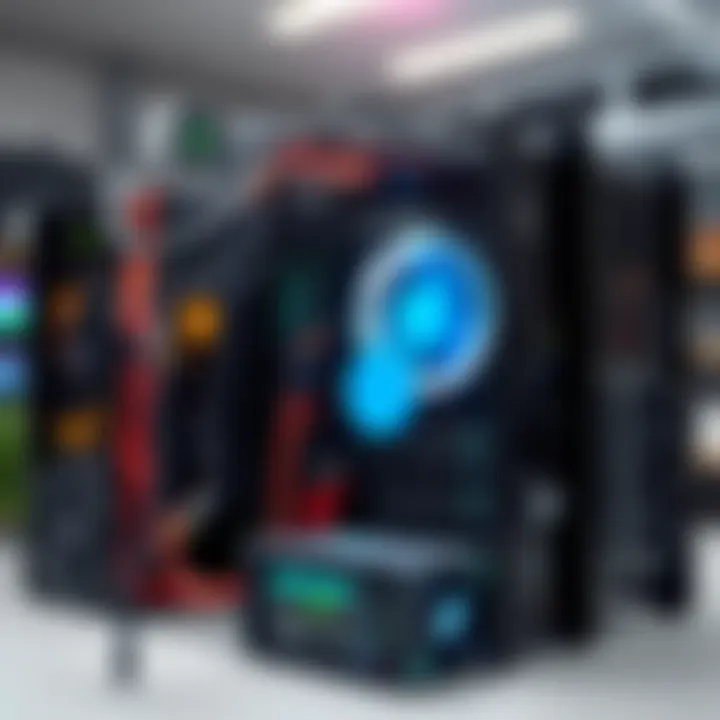Understanding Ripple Mining Rigs: Insights and Imperatives


Intro
As the world of cryptocurrency continues to expand, understanding the specifics of various digital currencies has become crucial for investors and enthusiasts alike. The mechanisms behind these currencies are often complex, particularly when considering unique players like Ripple. Ripple's architecture, which diverges from conventional mining practices, essentially reshapes how value is exchanged and transaction speed is measured in the blockchain context. Although the term mining often conjures images of high-powered rigs and energy consumption, Ripple employs a different methodology altogether. By exploring the realm of Ripple mining, one can appreciate not only how it operates but also its significance within the broader cryptocurrency ecosystem.
In the succeeding sections, we will dissect the operational complexities of Ripple and its consensus mechanism, navigate the intricacies of mining rig setups, and shed light on both the prospects and challenges that miners encounter in this unique environment. This isn't merely an academic exercise; it’s an essential investigation for anyone serious about making their mark in the crypto space.
Let’s jump into the key concepts underpinning the fascinating world of cryptocurrency.
Key Concepts in Cryptocurrency
Understanding Blockchain Technology
At its core, the blockchain is a decentralized ledger technology that guarantees the integrity and transparency of transactions. Unlike traditional ledgers, the blockchain remains open and accessible to all participants. Here’s how it stands apart:
- Decentralization: Control isn't concentrated in a single entity, reducing the risk of fraud or manipulation.
- Transparency: Every transaction is recorded publicly, which aids in maintaining accountability.
- Immutability: Once data is entered into the blockchain, altering that data becomes virtually impossible.
The Ripple protocol capitalizes on these features to facilitate fast transactions between different fiat currencies. Transactions are settled almost instantaneously, a stark contrast to traditional banking systems which can take days.
The Role of Smart Contracts
Smart contracts are another game-changer in the cryptocurrency sector. These are self-executing contracts with terms of the agreement directly written into code.
- Automation: Smart contracts automatically execute terms once conditions are met, reducing human intervention.
- Cost Efficiency: They eliminate the need for intermediaries, lowering transaction costs significantly.
- Reliability: By leveraging blockchain's security, smart contracts provide a degree of trust that traditional agreements fail to deliver.
Ripple's integration of smart contracts into its ecosystem enhances the speed and efficiency of cross-border transactions, making it an attractive option for many financial institutions.
"The incorporation of smart contracts into Ripple's framework could very well be the bridge towards a more integrated financial future."
Next, we will explore the current market trends related to Ripple and the broader cryptocurrency landscape.
Market Trends and Analysis
Current Market Dynamics
The cryptocurrency market is ever-evolving, with different currencies gaining or losing traction swiftly. Ripple has frequently positioned itself as a major player, particularly due to its utility in facilitating swift international transactions.
- Market Adoption: Many banks and financial entities are embracing Ripple for its efficiency and low transaction costs.
- Volatility: Ripple's price, like many cryptos, has been notably volatile, impacting investor behavior.
Understanding these dynamics can help investors make informed decisions regarding their involvement with Ripple and similar assets.
Predictions for Emerging Cryptocurrencies
As we look forward, the spotlight is on newly emerging cryptocurrencies that could challenge established players. Factors to watch include:
- Technological Advances: Innovations that enhance speed, security, or energy efficiency.
- Regulatory Frameworks: How governments evolve their approach to cryptocurrencies will profoundly impact their legitimacy and acceptance.
- Market Demand: Shifts in consumer preference can rapidly alter the landscape.
By paying close attention to these trends, investors can better navigate the complexities of the cryptocurrency universe.
For more information on cryptocurrency trends, visit CoinDesk.
Stay tuned for our next section where we dissect the Ripple mining rig setup and its operational nuances.
Prologue to Ripple and Its Ecosystem
Ripple stands as a significant player in the world of digital currencies, capturing attention for its distinct offerings and technology. This first section serves as a foundational element for those looking to comprehend the broader implications of Ripple within the cryptocurrency space. Understanding Ripple goes beyond just its currency; it encompasses its underlying technology, its role in the economy, as well as the strategic relationships it has established. Those diving into Ripple, whether investors, developers, or analysts, need to get the nuts and bolts of Ripple's ecosystem to make informed decisions and viewpoints.
Overview of Ripple's Technology
Ripple operates on a unique framework that distinguishes it from traditional cryptocurrencies like Bitcoin or Ethereum. At its core lies the Ripple Protocol Consensus Algorithm (RPCA), which facilitates transactions between network participants without the need for mining, unlike Bitcoin's proof-of-work system. This technology is designed to enable quick, cross-border transactions, making it an appealing option for financial institutions. What sets Ripple apart is its goal of streamlining the traditional banking system, making it not just a currency but a comprehensive solution for financial exchanges.


Ripple’s ledger, known as the XRP Ledger, offers transparency and efficiency. It can handle up to 1,500 transactions per second, a remarkable feat compared to Bitcoin’s meager 7 transactions or Ethereum’s 30. By adopting a different consensus mechanism, Ripple enhances the overall performance while eliminating many issues prevalent in other blockchain systems, like excessive energy usage and transaction delays. Thus, understanding this technology lays a crucial foundation for anyone seeking to engage with Ripple in a meaningful way.
The Role of Ripple in the Blockchain Landscape
Ripple plays a pivotal role in the evolving landscape of blockchain technology. Unlike many cryptocurrencies that primarily function as stores of value or speculative assets, Ripple positions itself as a bridge currency. This means it facilitates liquidity in transactions by allowing easy exchanges between different fiat currencies. For banks and other financial entities, utilizing Ripple can streamline their operations significantly.
Ripple's focus on practicality—by focusing on direct partnerships with financial institutions—sets it apart from its peers. By addressing the specific needs of financial systems, it can potentially reduce transaction costs and speeds, reshaping how institutions engage with global payments. The collaboration with banks globally not only highlights Ripple’s ambition but also signals a growing acceptance of blockchain technology in traditional finance. As such, analyzing Ripple's place in this larger ecosystem of fintech solutions provides essential context for understanding its significance and potential future developments.
Defining Ripple Mining Rigs
Ripple mining rigs are pivotal in the growing ecosystem of cryptocurrencies, primarily due to their distinct approach to validating transactions. The term itself is somewhat of a misnomer because Ripple, unlike most cryptocurrencies that rely on energy-intensive mining operations, operates based on a consensus protocol. Still, it is crucial to dissect what constitutes a Ripple mining rig for those interested in tapping into this unique niche of cryptocurrency operations.
What Constitutes a Ripple Mining Rig?
A Ripple mining rig essentially refers to the setup of hardware and software necessary to interface with the Ripple network, known for the digital asset XRP. Unlike other blockchain networks that operate on proof-of-work systems, Ripple employs a consensus mechanism using the Ripple Protocol Consensus Algorithm (RPCA). This means the concept of mining as found in Bitcoin or Ethereum doesn't apply here in the traditional sense.
While traditional mining rigs use powerful GPUs or ASICs to solve complex mathematical problems, Ripple uses validators to confirm transactions. Here are some elements associated with a Ripple mining rig:
- Server Hardware: While you do not need massive processing power, running a reliable server is essential. Often, standard servers with a good amount of RAM and decent bandwidth are sufficient.
- Software: Implementing the correct Ripple software is non-negotiable. Ripple offers the Ripplenet software that needs to be configured properly. Each validator needs to be set up to participate effectively in consensus.
- Network Connectivity: As Ripple's operations are heavily dependent on network communication, having a stable and preferably high-speed Internet connection is vital. A poor connection could result in missed transactions or delays in validation.
- Validation Setting: Each node must be configured correctly to ensure that it can effectively validate transactions in line with Ripple’s algorithm. This entails joining a unique set of validators to ensure the reliability of the transactions you're confirming.
In essence, setting up a Ripple mining rig is more about establishing a robust server environment than creating the high-powered machines generally associated with mining.
Comparison to Traditional Mining Rigs
When comparing Ripple mining rigs to traditional mining rigs, one cannot ignore the fundamental differences in their operational mechanics.
- Energy Consumption: Traditional mining, especially in proof-of-work systems, requires significant energy—not only to power the rigs themselves but also for cooling systems. Ripple's consensus mechanism, however, is much less energy-intensive. This is a double-edged sword, as the reduced energy consumption also leads to less profit in certain scenarios due to the lack of mining rewards.
- Profit Mechanism: In conventional mining, miners compete to solve problems to earn a block reward and transaction fees. Ripple does not offer indiscriminate rewards for all validators. Instead, their participation is rewarded through transaction fees, which means profits can be less predictable and significantly lower.
- Complexity of Setup: Setting up a traditional mining rig involves various specialized hardware components and often entails considerable investment. In contrast, establishing a Ripple rig may seem simpler, although understanding and implementing the consensus protocols can be complex.
- Flexibility: Traditional mining rigs can be repurposed, upgraded, or expanded as technology evolves. With Ripple, since the technology is built on a consensus model, the hardware requirements become much less relevant, and the focus shifts to network participation.
"Once you understand the basics of Ripple’s network, the importance of mining rigs becomes clearer as facilitators of a fast, efficient, and energy-conscious ecosystem."
Understanding Ripple's Consensus Mechanism
Understanding Ripple's consensus mechanism is crucial for grasping how the Ripple network maintains its integrity and efficiency. This mechanism, unique to Ripple, is not only about confirming transactions but also about ensuring that the network operates in a secure and reliable manner. Unlike traditional mining methods, which rely heavily on solving complex mathematical problems, Ripple employs a consensus among the validators to agree upon the state of the ledger. This distinction has several implications, particularly regarding transaction speed, energy consumption, and network decentralization.
How the Consensus Algorithm Works
The core of Ripple's consensus process revolves around the unique protocol known as the Ripple Protocol Consensus Algorithm (RPCA). Essentially, each transaction must be verified by a selected group of validators. These validators are crucial to the workings of Ripple, as they stand as trusted entities who agree on the legitimacy of transactions. The process can be broken down into a few crucial steps:
- Transaction Proposal: When a transaction is initiated, it is broadcast to the network and collected by validators.
- Validation Process: These validators check the validity of the transaction against the current state of the ledger. They employ a set of predefined rules to assess whether the transaction is legitimate, ensuring participants are not double-spending or engaging in fraudulent activities.
- Consensus Reach: Once a certain threshold of validators approves the transaction, it is added to the ledger. This typically occurs within seconds, significantly faster than many traditional blockchain systems.
- Ledger Update: After transactions are confirmed, the ledger is updated to reflect the new state, maintaining a record that is immutable and transparent.
The beauty of RPCA lies in its ability to achieve consensus without resource-intensive computations, drastically reducing both transaction time and energy usage. The system is designed to be lightweight while still providing robust security, which is a major selling point in a world increasingly concerned about environmental impacts of mining operations.
Differences from Proof of Work Systems
The contrast between Ripple’s consensus mechanism and the traditional Proof of Work (PoW) system is stark. In PoW, miners solve complex mathematical puzzles to validate transactions and create new blocks in a competitive environment. This process can use vast amounts of energy, leading to concerns about its sustainability.
In comparison, Ripple’s method sidesteps these issues. Here are key differences:
- Speed: Ripple transactions can be validated in mere seconds, while PoW can take minutes to hours, particularly when the network is congested.
- Energy Consumption: Ripple’s validators require minimal computational resources compared to PoW miners who need extensive hardware and electricity. This leads to a lower carbon footprint.
- Centralization vs. Decentralization: While some argue that Ripple’s reliance on a limited pool of validators risks centralization, supporters argue that it creates a stable network. PoW networks often face issues with centralization due to mining pools monopolizing power.
- Security Models: Both systems provide security but through different means. Ripple relies on trust relationships among validators, while PoW relies on computational power.
In summary, understanding Ripple’s consensus mechanism is essential for anyone involved in Ripple mining or looking to invest in cryptocurrencies. The unique properties of Ripple’s protocol not only shape how transactions are processed but also illustrate a different philosophy towards achieving consensus in the crypto space.
Setting Up a Ripple Mining Rig
Setting up a Ripple mining rig is akin to laying down the foundation for a solid structure; it establishes the groundwork for potential success in the intricate world of cryptocurrency mining. The process requires meticulous attention to detail as it encompasses various components, both hardware and software, essential for effective operation. Recognizing the importance of this setup allows miners to leverage Ripple's unique consensus based system effectively, ensuring that their investments yield beneficial returns. As the cryptocurrency market continues to evolve, understanding what goes into building a functional mining rig remains crucial for investors and enthusiasts alike.
Essential Hardware Components
Creating a Ripple mining rig isn’t just about slapping together a few bits and bobs from the local store; it’s a careful selection of hardware that would fit the needs of Ripple's architecture. Here’s what you need to consider:


- Servers: Unlike conventional mining with physical graphics cards, Ripple utilizes servers. A reliable server setup is fundamental, ensuring consistent performance and efficient maintenance.
- Network Equipment: Internet connectivity is non-negotiable in the mining game. A solid and fast internet connection keeps your rig online, ensuring that you stay updated with the latest network transactions.
- Storage: It's not just the flashy components that matter; having adequate storage, whether SSD or HDD, can significantly affect the speed at which data is processed and stored. A good practice is to invest in SSDs as they are faster and more reliable.
- Power Supply: Miners often overlook the power supply, but it’s crucial. A quality power supply can prevent downtime and operational hiccups.
Setting up these components correctly lays the groundwork for a well-functioning system and can optimize the mining process.
Software Requirements
On the software side, a Ripple mining rig needs the right frameworks and applications to begin its dance with the blockchain. Choosing the appropriate software isn’t only about what’s popular; it’s about functionality and compatibility with Ripple’s specific architecture:
- Rippled: This is the Ripple protocol that acts as a gateway, managing transactions and facilitating communication within the network. Setting it up requires familiarity with command-line interfaces, so a bit of tech-savvy won't hurt.
- Node Management Tools: These tools help monitor the health and status of your mining operation. They allow you to check uptime and resources, ensuring everything runs smoothly.
- Security Software: As a miner, you’ll be handling sensitive data, so it's wise to invest in reliable security protocols, including firewalls and anti-malware software.
Using the right software significantly boosts your rig's efficacy and overall safety while you engage with Ripple's ecosystem.
Configuration Steps
Once the hardware is assembled, and software is installed, it’s time to dive into configuration. This is where finesse comes into play.
- Setting Up the Server: Start by integrating your chosen operating system with the hardware. Each component should be installed and recognized by the system.
- Installing Rippled: Follow documentation provided on Ripple's official website to install Rippled. Pay close attention to dependencies that may be required.
- Configuring Network Settings: You’ll want to tweak your network settings to ensure that your server communicates seamlessly with Ripple’s ledger. This might include Port Management and adjusting router settings to allow external access if necessary.
- Linking to Your Wallet: Don’t forget to connect your mining rig to your Ripple wallet. This ensures that your mined assets will flow directly into your control.
- Testing the Setup: Finally, run diagnostics to ensure everything functions as expected. Address any encountered issues right away to avoid unnecessary downtime.
Setting up a Ripple mining rig is no small feat. It requires both knowledge and precision. However, when done correctly, it not only opens the door to potential profits but also immerses the miner into the rapidly expanding realm of Ripple and blockchain technology. By taking the time to understand essential hardware, software, and configuration steps, enthusiasts can navigate their mining journey with greater confidence.
For further reading, you might find these resources helpful:
- Ripple Official Site
- Wikipedia on Ripple
- Ripple Community on Reddit
- Government Regulations on Cryptocurrencies
- Educational Resources on Blockchain Technology
Economic Considerations in Mining Ripple
The financial aspects of mining Ripple stand as a formidable pillar in determining the viability and sustainability of operations within this domain. When diving into the world of Ripple mining, it's important to grasp the economic reality that governs such ventures. The costs, potential revenue, and ongoing expenses can shape decisions significantly, making it vital for investors and participants to have their heads wrapped around these elements before taking the plunge.
Cost of Equipment and Setup
Entering the Ripple mining realm is not a small feat. The initial investment can be a considerable hurdle for newcomers. The equipment required varies significantly from the traditional methods commonly associated with Bitcoin mining. Ripple operates on a unique consensus mechanism that does not necessitate the power-hungry rigs often seen in other cryptocurrency mining. Yet, essentials are still needed.
- Hardware Requirements
To kick off, miners generally need a dedicated computer that has adequate processing power, but there’s no need for extravagant GPU setups. A solid CPU can suffice in many cases, minimizing equipment costs. - Software Choices
Another factor is the software. There’s a range of platforms available that allow users to connect to the Ripple network. While some of these may come with fees, others can be utilized for free, pending configuration and learning curve. - Network Connectivity
A reliable internet connection is essential for any miner, ensuring low latency in transactions and communication with other nodes. It’s a necessity that often goes overlooked, but can cause significant issues if not prioritized.
"Investing in equipment isn’t just a one-time deal; it's pivotal to think about long-term efficiency and updates that will be needed as technology evolves."
The combined costs of hardware and installation of software can range from a few hundred to thousands of dollars, depending on how extensive the setup is envisioned to be. Importantly, analyzing and projecting these setup costs should be at the forefront of any exploratory discussions about engaging in Ripple mining.
Operational Expenses and Profitability
Understanding the ongoing expenses is equally critical if one wants to gauge the profitability of Ripple mining. Once initial costs are accounted for, it’s the operating expenses that can really add or subtract from a miner’s bottom line. Unlike traditional mining, Ripple's mining mechanism entails different aspects to consider.
- Energy Consumption
While Ripple has lower energy demands compared to other cryptocurrencies, electricity costs still play a role. Understanding power consumption and how it impacts operational budgets is essential. Swings in electricity prices can eat into profits significantly if not properly accounted for. - Maintenance Costs
All equipment requires upkeep. From software updates to physical hardware checks, unforeseen costs can crop up. Keeping systems running smoothly means being prepared for these maintenance tasks that may require time and additional funds. - Market Fluctuations
The profitability of mining Ripple is also heavily influenced by market trends and Ripple's market value. Sudden dips in price can result in lower-than-expected returns, prompting an immediate reassessment of one’s mining strategy.
Opportunities and Risks in Ripple Mining
Ripple mining presents a blend of opportunities and risks that are crucial for investors and miners to comprehend thoroughly. Understanding these aspects helps prospective miners navigate the murky waters of cryptocurrency investments while weighing the potential rewards against the accompanying challenges. The unique nature of Ripple, particularly its consensus mechanism and the structure of its ecosystem, creates a range of prospects alongside pertinent considerations for miners.
Potential Gains from Mining Ripple
The attraction of mining Ripple lies primarily in its potential profitability. Here are several aspects that contribute to possible gains:
- High Liquidity: Ripple has gained traction as a means for banks and financial institutions to facilitate cross-border payments. Its increasing demand translates into significant liquidity, which can offer miners a chance for high returns.
- Lower Competition: Compared to Bitcoin mining, which is highly competitive and requires significant resources, Ripple mining does not demand as much computational power, making it more accessible for new entrants.
- Ecosystem Partnerships: Ripple's strategic partnerships with well-established financial institutions bolster confidence in its long-term viability. Miners may benefit from dividend-like rewards as Ripple expands its use cases within the financial realm.
- Lower Operating Costs: Mining Ripple can often involve lower energy costs due to the efficiency of its consensus mechanism, which does not rely heavily on energy-intensive computations like traditional Proof of Work systems. This efficiency can aid in preserving profit margins.
Understanding these potential advantages is essential for anyone entering the Ripple mining space. However, it is just as crucial to remain aware of the risks that accompany these opportunities.
Challenges Facing Miners
Despite the enticing benefits, miners need to keep an eye out for various challenges that can hinder success or profitability in the Ripple mining landscape:


- Market Volatility: Like many cryptocurrencies, Ripple is subject to rapid price fluctuations. A downturn in the market can significantly impact the profitability of mining operations, potentially turning a venture into losses.
- Regulatory Scrutiny: The regulatory landscape around cryptocurrencies is still evolving, and changes can impact Ripple's operation, including its mining dynamics. Any strict regulations could adversely affect mining practices and, by extension, the earnings potential.
- Technological Changes: The tech behind Ripple is constantly evolving. Miners must keep abreast of updates in both software and hardware to ensure they are not left behind, which may require additional investments.
- Operational Risks: These include downtime due to hardware failures or issues with software compatibility. If miners fail to maintain their rigs efficiently, it can lead to losses that may not be easily recoverable.
Future of Ripple Mining
The future of Ripple mining holds a significant place within the larger narrative of cryptocurrency. As the digital currency landscape evolves, so too does the technology that underpins it. Understanding these shifts isn't just useful; it's vital for investors, educators, developers, analysts, and marketers to navigate the terrain ahead. Given the rapid advancement of mining technology and the regulatory frameworks that govern these operations, staying informed about future trends can unlock new opportunities.
Projected Trends in Mining Technology
A deeper look at the projected trends in mining technology reveals an industry that is increasingly adapting to technological advancements. As resource efficiency becomes more critical, there’s an expected rise in the adoption of greener technologies.
- Integration of AI and Machine Learning: These technologies are expected to optimize operations, making mining processes smarter and more efficient. By analyzing performance data in real-time, AI can adapt strategies promptly, leading to better resource allocation.
- Cloud Mining Services: More miners might turn to cloud services instead of investing in physical rigs. This shift could provide easier access for novice investors, lowering the barrier to entry while still engaging with Ripple mining.
- Advanced Cooling Solutions: As heat management becomes a focal point for efficiency, innovative cooling solutions are likely to emerge. Liquid cooling and energy-efficient hardware could make a significant difference in prolonging equipment lifespan while reducing energy consumption.
These trends reflect the industry's ability to adapt and innovate in response to both market demands and environmental concerns.
Regulatory Impacts on Mining Operations
As regulators catch up with the rapid pace of cryptocurrency developments, the impact on Ripple mining cannot be overstated. It is essential for operators and investors to grasp the implications of these changes.
- Increased Oversight: Governments around the world are beginning to scrutinize cryptocurrency mining operations more closely. This trend can lead to new compliance requirements that could increase operational costs, thus impacting profitability.
- Sustainability Regulations: As environmental concerns rise, some regions may impose stricter regulations on energy consumption. This could make it more challenging for certain operations to thrive unless they prioritize sustainability.
- Tax Implications: The evolving legal framework will influence how profits from Ripple mining are taxed. Understanding these implications is crucial for financial planning and ensuring long-term viability.
"Staying compliant with regulatory changes not only shields miners from potential penalties but also enhances the legitimacy of Ripple mining as a whole."
The regulatory landscape is not just a challenge; it can also create opportunities for those willing to adapt. By navigating these changes thoughtfully, miners can position themselves for sustained success in this dynamic field.
Case Studies of Successful Ripple Mining Operations
Studying successful Ripple mining operations offers valuable insights into the practical application of knowledge in this dynamic field. These case studies encompass a variety of approaches, strategies, and technologies utilized by leading miners, which can serve as both guidance and inspiration for new entrants into the mining ecosystem. In an arena where every decision can mean the difference between profit and loss, learning from those who have navigated the turbulent waters of Ripple mining can provide a clearer path forward.
Analyzing Leading Miners in the Sector
To get a grip on what success looks like in Ripple mining, analyzing the performance of industry frontrunners is crucial. Companies like RippleX and Bitso have leveraged their understanding of Ripple's technology while skillfully managing operational costs. Through their sophisticated mining rigs, these entities have not only maximized their return on investment but also contributed to the overall stability of the Ripple network.
One aspect worth noting is how these leading miners often adopt a multi-faceted approach. They utilize advanced software that constantly monitors market trends and adjusts mining configurations for optimal output. A systematic setup allows them to dynamically scale resources in response to fluctuations in network demands. This adaptability plays a key role in enhancing their competitive edge.
Additionally, many of these successful miners have established partnerships within the Ripple community. Such collaborations tend to yield mutually beneficial outcomes and foster growth by sharing insights, refining technologies, and optimizing resource management.
Lessons Learned from Failures
While success stories are illuminating, examining failures in Ripple mining is just as informative. The pitfalls faced by miners in the past can be illustrative warnings for those looking to enter the field. For instance, many startups have faltered due to inadequate understanding of Ripple's unique dynamics when compared to traditional cryptocurrencies. A lack of awareness regarding the setup and ongoing maintenance of mining rigs proved detrimental for several well-funded operations.
Moreover, failed ventures have often underestimated the capital and operational costs involved. Misjudgments in budgeting can lead to a downward spiral—failing to meet financial obligations can cripple a mining operation's viability.
"Learning from failures is essential. It helps to avoid the same mistakes, which is invaluable in a fast-paced market like cryptocurrency."
Ultimately, those who scrutinize both triumphs and tribulations are better positioned to make informed decisions in their Ripple mining journeys. They learn not only what works but also what doesn’t. By tethering their strategies to insights gleaned from past experiences, budding miners can avoid common missteps and foster a more resilient operation.
Culmination
In rounding off our exploration of Ripple mining rigs, it's crucial to distill the essence of what has been discussed. This topic is not merely academic; it bears significant implications for anyone who wishes to dive into the realm of cryptocurrency, especially Ripple.
Ripple has crafted a unique niche in the blockchain landscape, offering not only transaction speed but also scalability and sustainability. These characteristics inherently define the importance of Ripple mining, which differs greatly from traditional mining practices often dominated by proof-of-work systems. It opens new doors for investors, educators, developers, analysts, and marketers to engage with the digital currency environment in innovative ways.
Summarizing Key Insights
To put things in perspective, the key insights gained from this article include:
- Ripple's Consensus Mechanism: This stands out as a pivotal feature. Unlike the resource-intensive proof-of-work, Ripple uses a consensus protocol that is energy-efficient and includes a unique approach involving validation nodes which positions it more favorably against environmental concerns.
- Cost Considerations and Setup: The financial aspects matter significantly. Starting with a Ripple mining rig can be less demanding compared to traditional mining, requiring less hardware overhead and making entry easier for novices.
- Opportunities vs. Risks: Like any venture, miners must weigh the potential gains against inherent challenges. Fluctuating market conditions and regulatory nuances can greatly influence profitability, making it imperative for miners to stay informed and sustain flexible strategies.
Final Thoughts on Ripple Mining
Looking ahead, the future of Ripple mining hinges on evolving technology and market dynamics. As mining rigs advance, they will undoubtedly require ongoing assessments in terms of efficiency and cost-effectiveness. Moreover, the regulatory landscape surrounding cryptocurrencies continues to shift. Thus, staying abreast of these changes is not just advantageous; it’s essential. Investors and stakeholders must be prepared for potential legislative impacts that could redefine how mining is approached in the future.
"The future belongs to those who believe in the beauty of their dreams.”
For further reading, you might find interesting insights on Wikipedia’s XRP page, or explore broader blockchain communities on Reddit.
Ultimately, keeping these considerations at the forefront will ensure that stakeholders can harness the potential of Ripple mining effectively.







